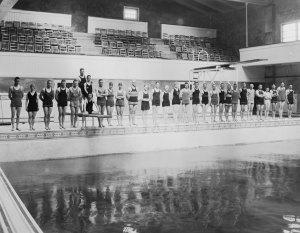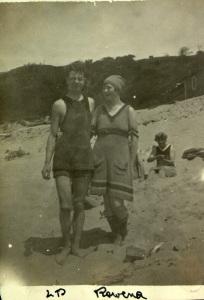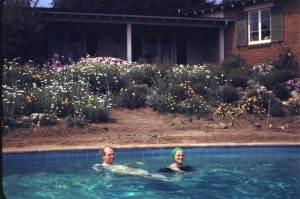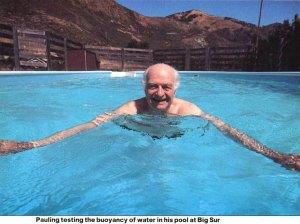
The Men’s Gymnasium pool at Oregon Agricultural College, ca. 1920s. This is where Linus Pauling would have taken his required swim test. Or did he…?
An odd nugget came across our desk recently. From a column titled “Myth of Harvard swimming rule sinks 50 yards short of truth,” published in the Pasadena Star-News and authored by Robert Rector, we read
As recently as two years ago, many schools still had the compulsory swimming requirement, among them MIT, Columbia, Bryn Mawr, Washington and Lee, Dartmouth and Notre Dame.
And like Harvard, the test has become the stuff of legends.
One such tale holds that during the 1920s, Oregon State University had such a requirement, and Linus Pauling, who would go on to win two Nobel Prizes, could not swim a stroke. It was rumored that someone donned his number and swam for him.
It is most certainly true that, during Pauling’s time and for many decades following, Oregon Agricultural College did require that it’s students learn to swim before they could graduate. (Presumably this was in keeping with the land grant mission of attaining practical knowledge, though it is less clear why the male students took their swim lessons and tests au naturale. Allegedly it had something to do with the college pool’s filters.) The unsourced bit about Pauling pulling a fast one is new to us and seems unlikely.

Pauling at the Oregon coast with his cousin Rowena, 1918.
Young Pauling didn’t have any qualms about bending rules that he thought silly or inconvenient. He infamously tried out for the college track team in order to avoid OAC’s physical education class requirements, a plan that fizzled rather quickly.
The idea that Pauling did not know how to swim, however, strikes us as improbable. For one, OAC was a pretty small community back then – just over 3,400 boys were enrolled by the time that Pauling graduated – and it would seem to have been more difficult to slip a body double past the watchful eyes of the examiners. As a four-year ROTC cadet, one also supposes that swimming may have entered his military curriculum along the way. Pauling and his cousin Mervyn likewise spent six weeks during the summer of 1918 helping to build wooden-hulled freighters on an Oregon coast shipyard.
More telling for us, however, is this early scene from Tom Hager‘s biography, Force of Nature. It describes the exploits of a fifteen year old boy, living in Portland, Oregon, who was hellbent on outfitting his basement chemistry laboratory.
His greatest feat was the transport of a small, brick-lined electric furnace [scavenged from an abandoned smelter in Oswego, Oregon]. Since it could not be disassembled, he talked a friend into helping him haul it down to the river, where they loaded it into a borrowed canoe, paddled miles downriver, then pushed it two miles home up Hawthorne Boulevard in a wheelbarrow.
The teenaged Pauling, it would seem, either knew how to swim or was very brave. (or foolish)

Linus and Ava Helen in their Pasadena pool.
Regardless, by 1950 Pauling had definitely sorted out his water skills to the point of building a swimming pool at his Pasadena home. Dubbed “the pool that General Chemistry built,” the feature was funded by Pauling’s book royalties and very quickly became a bit famous. As Ken Hedberg recalled in 1995
The Paulings had built a very nice swimming pool just below the house, a feature that made the baby-sitting task a real pleasure in the warm Pasadena summers. The children were a very lively bunch, and had a tendency (at least Linda and Peter did) to cruise through Crellin Laboratory and invite people up for swimming parties when their parents were away. There was one occasion, I believe it was during or just after such a party, when the senior Paulings came walking up the drive. I could only say, “But , I thought you were in Europe!” I do not remember their response. I do remember, though, that it did not seem to matter to either Peter or Linda whether their parents were there or not. The Paulings must have been sorely tried now and then, for once Ava Helen spoke firmly through one of the windows, “Linda, can you get rid of those people, your father and I want to swim!” It was a very reasonable request: there were so many people that there was almost no room in the pool. We all left very quickly.
The pool played a memorable role in Matthew Meselson‘s life as well
I became a graduate student of Pauling’s by an accident that involved a swimming pool. One afternoon in the summer of 1953, Peter Pauling, Linus’ middle son, had some friends over for a swim. Linus came out of the house, dressed in a tie and a jacket, and peered down at me (I was in the water, not at all well-dressed) and he said “Well, Matt, what are you going to do next year?” (You’ve got to have this picture in your mind – I am all wet, largely naked, looking up at the world’s greatest chemist, who is wearing a tie and a jacket. For someone growing up in California, that alone is intimidating). So I said I was going to go back to the University of Chicago, where I had been before, and I was going to be a graduate student of the Committee on Mathematical Biophysics. It was the only time I ever saw Linus looking amazed. After a moment he said, “But Matt, that is a lot of … baloney! Why don’t you come to Caltech and be my graduate student?” So I looked up at him and said, “Okay, I will.” And that was that.
Later on, the Paulings added a large pool adjacent to the “Big House” at Deer Flat Ranch, which is pictured below.
We’ll never know exactly when it started, but one thing is clear: be it for exercise, recreation or simple cooling off, swimming was very much ingrained into the fabric of life for Pauling and his family.

Illustration from “Linus Pauling: Vim, Vigor and Vitamins”, Discover, November 1982. Photo by Joe McNally.
